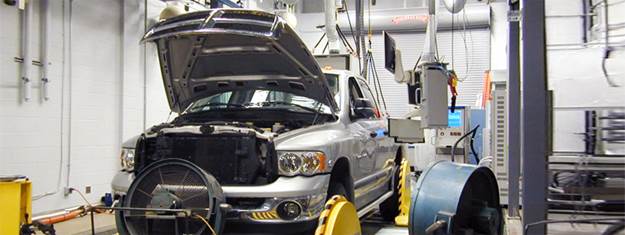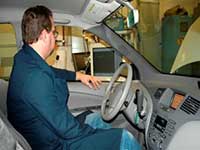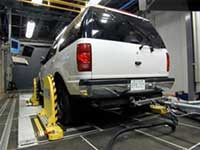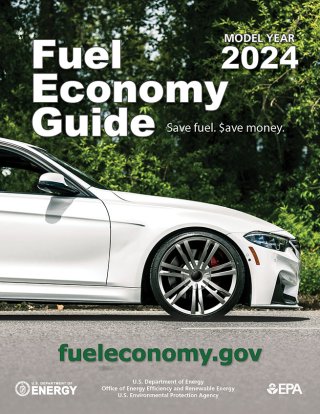Fuel Economy and EV Range Testing

EPA's National Vehicle and Fuel Emissions Laboratory (NVFEL) tests new cars and trucks sold in the U.S. to ensure that they comply with federal emissions and fuel economy standards.
Fuel Economy Testing
EPA is responsible for defining the methods used to calculate the fuel economy estimates that are posted on the window stickers of new cars and light trucks. EPA confirms approximately 15% of all test results, but it is the manufacturers that are responsible for providing the fuel economy data used for labeling. Automakers are required to follow very specific test procedures and submit the fuel economy data to EPA for all their models each year. In general, vehicles are tested over 5 defined test cycles that were created to represent typical driving conditions in the U.S.:
- City test - no heating, ventilation, or air conditioning (HVAC) operation
- Highway test - no HVAC operation
- More aggressive/high speed test - no HVAC operation
- Hot test at 95° F - HVAC set to cool the cabin
- Cold test at 20° F - HVAC set to specific settings for heat and defrost
The results of these tests are then combined and weighted to estimate average use, which results in official miles per gallon (MPG) values.
MPG equivalent (MPGe) is used for plug-in electric vehicles (PEVs). MPGe conveys the energy consumption in terms of how many miles the vehicle could go on an amount of fuel that has the equivalent energy content as a gallon of gasoline.
- Example - A gallon of gasoline has the energy equivalent of 33.7 kilowatt-hours of electricity. A PEV that uses 33.7 kilowatt-hours to drive 100 miles will use the energy equivalent of one gallon of gasoline and, therefore, would have an MPGe of 100 miles per gallon of gasoline equivalent.
- Note: MPGe values provided by EPA include charging losses. Charging a PEV is not 100% efficient. A small amount of energy is lost through energy conversion and heat. MPGe values assume level 2, alternating current (AC) charging and account for losses from the charging cable (also called the electric vehicle supply equipment or EVSE) and the on-board vehicle charger. This moves the measurement from the vehicle to the outlet in the wall to better represent how much users would pay to refuel their car.
For more details, visit Vehicle Certification and Compliance Testing.
Range Testing for Electric Vehicles
An all-electric vehicle (EV) produces no smog-forming or greenhouse gas emissions from its tailpipe. For EVs, vehicle testing provides important label information, such as fuel economy and range.
For EV Range Testing:
- A vehicle with a fully charged battery is driven continuously over the EPA city cycle until the battery is depleted and the vehicle can drive no further. The distance driven is recorded. This is repeated, again starting with a full charge, over the EPA highway cycle, again recording the distance driven when the battery is depleted. This “single cycle” test consists of multiple repeat drives of the city or highway cycle.
- Automakers also have the option of doing a multi-cycle test, which consists of four city cycles, two highway cycles, and two constant speed cycles.*
- All testing is done in a laboratory on a dynamometer.
- The city and highway driving ranges determined from this testing are adjusted to account for real-world factors that are not represented on the laboratory test procedures. These factors include such things the impact of air conditioning, of cold temperatures, and of high speed and aggressive driving behavior. Although the regulations allow some optional approaches, the most common approach is to use a factor of 0.7 to adjust all the test parameters, including range. For example:
- An EV achieves 200 miles on the highway laboratory test. Real-world highway driving range → 200 x 0.7 = 140 miles to account for aggressive driving and HVAC use.
- The adjusted city and highway range values are weighted together by 55% and 45%, respectively, to determine the combined city and highway driving range that appears on the EPA fuel economy label. For example:
- Assume an adjusted city range of 168 miles and an adjusted highway range of 140 (from example above). The official combined range value → (0.55 x 168) + (0.45 x 140) = 155 miles (values are rounded to the nearest whole number).
Specific details on testing can be found in EPA regulations at 40 CFR 600.116-12 - Special procedures related to electric vehicles and hybrid electric vehicles. For more information on the other acceptable (“optional”) approaches, visit 40 CFR 600.210-12 Calculation of fuel economy and CO2 emission values for labeling.
Certification Emission Testing
All new cars and trucks sold in the U.S. must be certified to meet federal emission standards, such as limits on the amount of smog-forming and greenhouse gas emissions that they can produce. Testing is done at EPA’s NVFEL facility and by vehicle manufacturers at their own facilities. EPA audits the data provided by vehicle manufacturers and performs its own testing on some of the vehicles to confirm the results.
The Lab Testing Process



* Some of these methods will differ for alternative-fueled vehicles, such as electric vehicles.
*The sequence consists of city cycle, highway cycle, city cycle, mid-test constant speed cycle, city cycle, highway cycle, city cycle, and end-of-test constant speed cycle.

